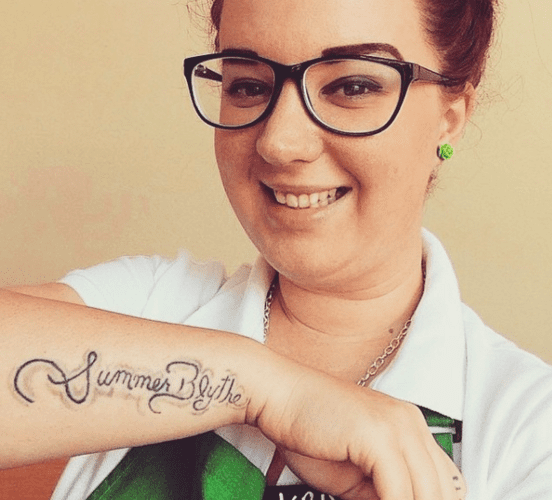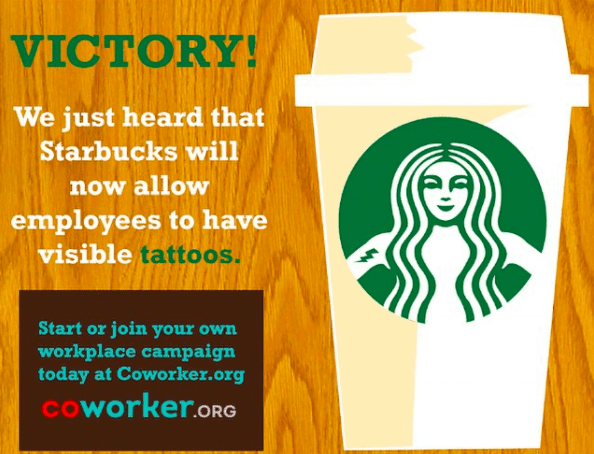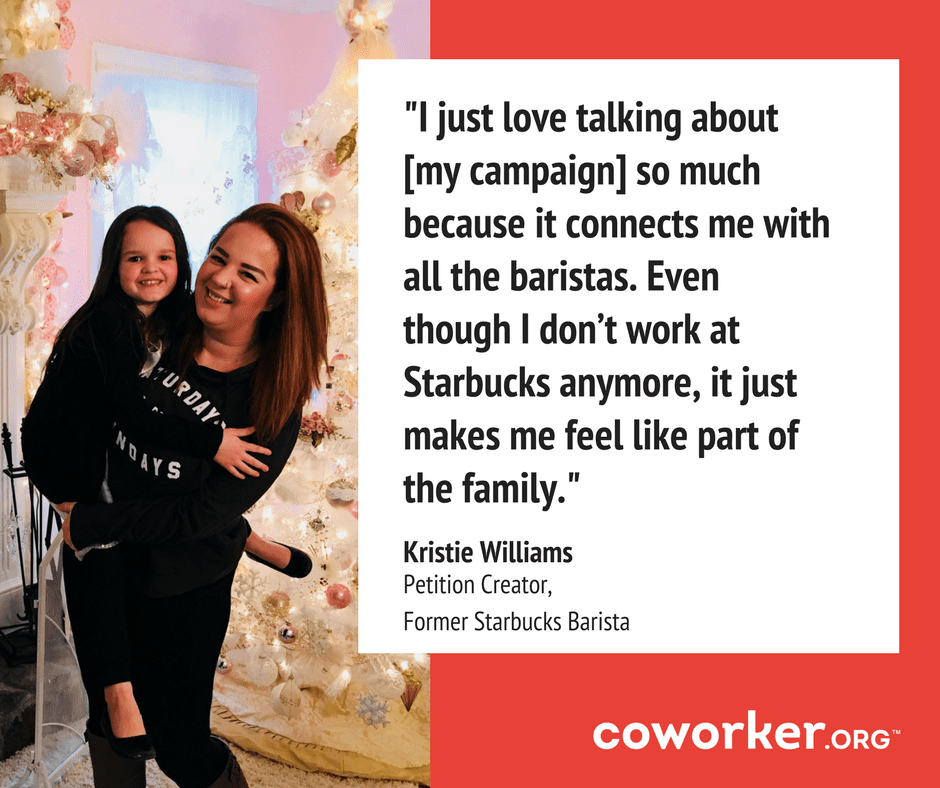Grounds for Change: How Baristas Won Visible Tattoos at Starbucks
FEB 20, 2018 | COWORKER.ORG
This campaign for visible tattoos at Starbucks inspired workers from all over the country to push for similar dress code changes.
While tattooed Starbucks baristas may seem commonplace now, that was not always the case. Prior to 2014, Starbucks did not allow baristas to have visible tattoos at work. It wasn’t until thousands of people from all over the world took action together through a barista-led petition on Coworker.org that the company changed its dress code policy related to tattoos. Now, Starbucks baristas make up one of the largest networks of employees on Coworker.org, with over 13% of Starbucks’ global workforce active on the site and more than 50 campaigns started by Starbucks baristas.
We asked former Starbucks barista and creator of the successful campaign for visible tattoos, Kristie Williams, about her experience making change in her workplace. She explains the importance of worker voice in formulating dress code policies and what it was like to lead a campaign with her coworkers.

To start off, tell us a little about yourself.
My name’s Kristie Williams, I worked at Starbucks on and off for four years. I loved it — I got promoted to keyholder at one point and went through the Coffee Masters program. Right now, I’m working at Ulta’s Clinique makeup counter. While I miss Starbucks every day, I make better money where I am right now, so I can support me and my daughter, Summer. Also, I love doing artwork. I remember designing the chalkboards at Starbucks. I love drawing, makeup, and I’m still coffee obsessed.
On October 20, 2014, you declared victory on your Coworker.org petition. Starbucks corporate was finally changing its dress code to allow partners to show their tattoos! Take us back to that moment. How did you feel?
I was so shocked. At work, people were talking about it when corporate sent us a memo that they were changing the dress code. I never thought that it would get as big as it did. It was crazy!
Did you know that workers at Skechers, Publix, and Jimmy John’s started similar dress code campaigns after being inspired by what you did at Starbucks? How does that make you feel?
I think that is so awesome. It’s crazy to think that my little petition inspired so many people. It all started when the air conditioning in our store broke on a really hot summer day. My coworker and I both had tattoos, so we had to wear long sleeves to work. I was so worried when she almost passed out because it got SO HOT working around all the machines, especially the espresso machine.
I just think it’s important for workers to be comfortable. As long as you are not wearing anything that is obscene or inappropriate, I don’t really see why it would create an issue.
“I just think it’s important for workers to be comfortable. As long as you are not wearing anything that is obscene or inappropriate, I don’t really see why it would create an issue.”
Whenever someone launches a dress code campaign on Coworker.org, someone always makes a comment to suggest there are “more important” issues to fight, for such as paid sick leave, wage increases, etc. How would you respond to these critiques?
When it comes to issues like wages, corporations have to take so many factors into account. It seems harder to change. On the other hand, simple dress code changes can allow employees to feel much more comfortable at work. I remember my long sleeves were always getting in the way of making drinks. It was really unsanitary to me how they would often be covered in milk and dishwater. When I tried to roll them up, my store manager would say, “But you can’t do that because your tattoos are showing.”
So, it wasn’t really about the importance of showing my tattoo, I was just trying to feel comfortable and do a good job at work. I think that people at the top of corporate at the time just might not have been aware of the fact that so many baristas were passionate about this issue. I also think that having beautiful pieces of art on your body could definitely help with enhancing customer connection — and Starbucks is all about the customer connection.

Why do you think corporate can sometimes be unaware of these issues and how can workers get their voices heard in those instances?
I think a lot of corporate people at the time might have seen many of these “tattooed young folks” as troublemakers.
There was just a bad stigma around people who had tattoos and it’s totally not like that anymore. Social media and petitions were the biggest ways to show corporate that these “tattooed young folks” are actually awesome employees.
Every Starbucks I go in to, the baristas are so friendly and want to get your drink the right way.
I don’t think that the dress code is going to hinder their work ethic. I understand Starbucks wanted to have this very professional look to them, but I think tattoos just give people character. It makes people seem more interesting when they don’t look like a cookie cutter image.
“There was just a bad stigma around people who had tattoos and it’s totally not like that anymore. Social media and petitions were the biggest ways to show corporate that these “tattooed young folks” are actually awesome employees.”
A significant moment in your campaign was when you launched the social media component. You encouraged Starbucks baristas who had to hide their tattoos at work to take photos of them and put them on Instagram with the hashtags #sbuxtattoos and #tobeapartner. What was it like seeing so many coworkers sharing their own photos and stories behind their tattoos?
That was another way to show corporate that our tattoos are beautiful and not inappropriate by any means. Furthermore, a lot of people’s tattoos have stories behind them. For example, I have my daughter’s name on me. If a customer was waiting and we were super busy, they can strike up a conversation asking, “Hey, who is Summer?”. It just gives a way for us to make that connection, so customers aren’t just standing there waiting for their order.
It’s great that you were able to fight tattoo stigma and show why the issue is important to workers on the day to day! It’s been 3 years since you won your campaign on Coworker.org. Looking back, how have your views on the role of employees in a workplace changed? What do you think you learned from this experience?
At the time, it was so shocking to me that it got so big. Now, I just think if you really have an issue, it’s probably the case that a lot of other people have the same issue. People from all these different states messaged me on Facebook thanking me for starting this campaign. It was crazy! I actually went into a Starbucks about an hour from home the other day and saw this girl just covered in tattoos. I wanted to bring it up so badly, but I didn’t because they were a little busy.
I just love talking about it so much because it connects me with all the baristas. Even though I don’t work at Starbucks anymore, it just makes me feel like part of the family.

Your campaign has inspired actions from baristas all over the world. What advice would you give to Starbucks baristas who are thinking about starting a campaign? Why do you think that the Starbucks workforce is so engaged in improving their workplaces and making a difference?
That’s so awesome! I know I started sharing my petition for visible tattoos more when I noticed that people were super interested in it. I joined more Starbucks groups and hashtagged it on Twitter. I would just tell people who start campaigns on Coworker.org to share, share, share. There are so many people who probably have the same issue as you do.
And I think baristas are engaged because they know that Starbucks is listening and they’re not close minded. I thought Starbucks seemed a little closed minded and corporate when I first joined in 2013. Now, it seems like they’re willing to listen to partners’ issues and make change according to employee voices.
What do you think you did well? What would you have done differently (if anything)?
Definitely the sharing part went very well. As far as doing things differently, I guess I would have started this sooner because I didn’t know how big it would get. I just thought it would be a cool little social media thing and get a few signatures. I had no idea it would really lead to the dress code change!
How do you think starting a Coworker.org campaign impacts your life today? Do your friends and family still talk about it?
It’s really cool. I just feel it was my 15 minutes of fame. It’s a fun little story I get to tell my new coworkers. My old coworkers at Starbucks still talk about it too. I have a little framed picture of some news articles about the campaign because I freaked out when I was on all these newspapers.
My mom bought copies. I was featured on Huffington Post, USA Today, and all these other outlets. My local radio station even talked about it and I’m so sad I missed it.
“I was featured on Huffington Post, USA Today, and all these other outlets. My local radio station even talked about it …”
Any other final thoughts?
Anyone who is doing a petition with Starbucks or any other company: share it. Even if you are a shy or reserved person, somebody out there is going through the same struggles and they will share it. I think that’s how mine got so big. I kept sharing it, other people kept sharing it, their friends and family kept sharing it, and it just got to be such a big thing. So, I just want to spread the encouragement. You can totally do it because other people have the same issues going on. I’m hoping in the near future, I can do something with Starbucks again, like go back part time. I don’t think my story at Starbucks is over at all.
Coworker.org is a global platform to advance change in the workplace. Our technology makes it easy for individuals or groups of employees to launch, join and win campaigns to improve their jobs and workplaces. You can start your own campaign about changes you want to see in your workplace on Coworker.org here — or contact us at [email protected] if you would like to discuss a workplace issue with our team.

